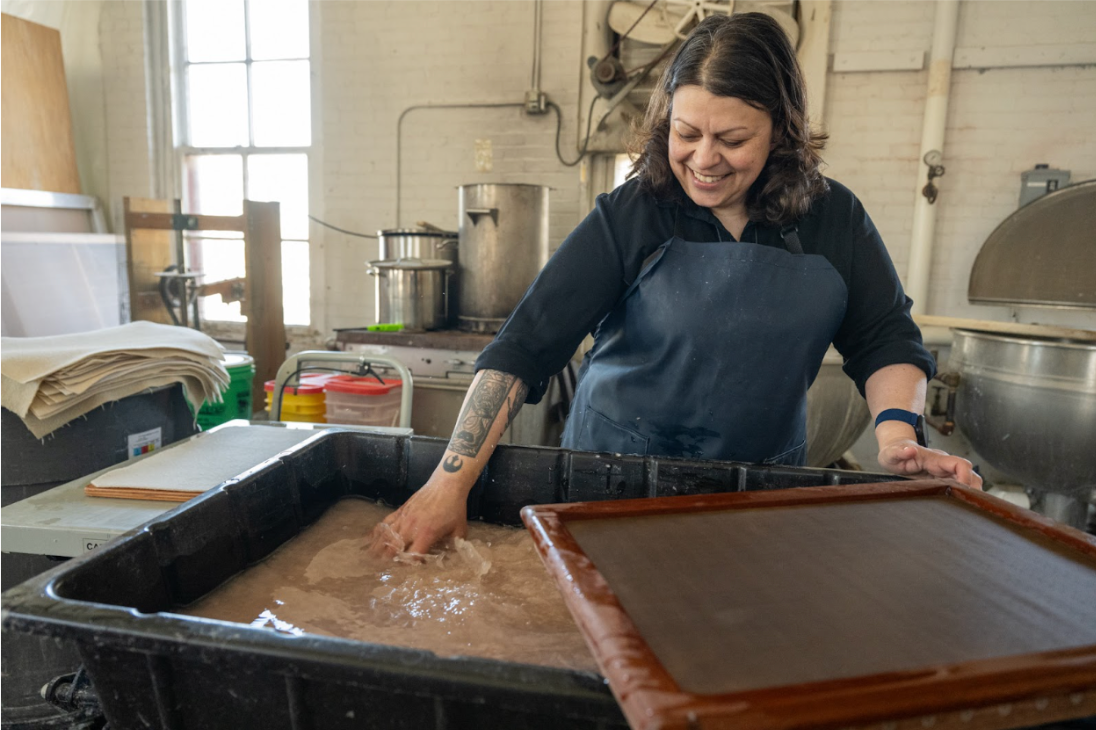Interview with Jamie Capps
Posted on June 11, 2025

Jamie Capps is a California-born artist based in Saint Paul. After years spent as a single parent navigating the corporate world, she returned to school at 40 and holds a BA from Mount Holyoke College and an MFA from the University of Iowa Center for the Book.
With a deep reverence for the handmade, Capps’s practice draws from cultural and folkloric traditions. Her work explores memory, mythology, and transformation through the tactile language of paper, print, and book forms. She creates layered pieces that reflect themes of resilience, the macabre, and the reimagining of familiar myths and stories—each one a testament to the enduring power of making.
Capps' work has been exhibited at institutions such as Cedar Crest College, the Evanston Art Center, the Morgan Conservatory, the Lyndon House, K.K. Merker Gallery, Public Space One, Mount Holyoke College Museum, Taber Gallery, and the Nishino Heritage House in Echizen, Japan.
Prompt Press: How did you get started in papermaking? What do you like about it?
Jamie Capps: I started making paper during undergrad. I attended Mount Holyoke College as a Frances Perkins Scholar, a scholarship program for nontraditional students. I entered as a junior, so I jumped straight into studio art courses and Intro to Papermaking was one of them. I hadn’t encountered a course like it before and was excited by the idea of making my own paper to use in my work.
My favorite is Japanese style papermaking, which is a meditative process. While there’s some measuring and calculating involved, much of it relies on muscle memory and your senses. There is nothing more satisfying than the process of cutting down paper mulberry (kozo) and spending days carefully processing the fiber into paper. The resulting sheets are thin, soft, and remarkably strong and are used across art, traditional Japanese crafts, design, and conservation.
Though I studied Japanese techniques specifically, it's important to recognize that many Asian countries process kozo and similar fibers using their own distinct tools and traditions. Each approach reflects a deep cultural connection to the material and process.
PP: What other mediums do you work in?
JC: I work across a range of printmaking techniques: plate lithography, letterpress, screen printing, and mokuhanga, pretty much anything I can do from my home studio or in the spaces I have access to. I also experiment with collage, and these mediums tend to overlap. For example, I might create a collage, photograph and digitally edit it, then transfer the image to a litho plate and print it onto handmade paper. Each process feeds into the next, allowing for a layered and evolving approach to image-making.
PP:Can you tell us about the last few years of work - major projects, thesis project, what you're working on now?
JC: Over the last few years in grad school, I spent most of my time diving deep into book arts, honing my papermaking skills, and doing research for my thesis project. I was lucky to have some amazing experiences—traveling to Echizen, Japan to study traditional papermaking with Nick Cladis and a few of my cohort, learning paper sculpting techniques from Akemi Martin at Penland School of Craft, and presenting at the North American Hand Papermakers conference in Rhode Island.
I've always had a love for American monster culture and Japanese kaiju and yōkai, as well as myths, legends, and fairy tales. For my thesis, I decided to blend those interests—reimagining yōkai through a distinctly American lens. The project completely took over my life (as thesis projects tend to do), and I wanted the final show to reflect how my different skills as a studio artist and book artist come together. The exhibition included a series of 3D pulp sculptures, a small edition of handmade and letterpress printed accordion books, and a large-scale accordion book filled with pulp drawings of my reimagined yōkai.
That work is still ongoing, and I’m currently in the early stages of creating a monster abecedarium—an illustrated alphabet of creatures that continues to mix cultural folklore with handmade paper and book forms.
PP: How does image-making play into your work? Writing? If at all.
JC: Images are essential to my work. I rely on visual elements—mark making, color, and composition—to tell a story. Occasionally, I include short poems or brief descriptions of a place or significant date, but my work isn’t text-heavy. While I don’t consider myself a writer, I enjoy collaborating with writers and drawing from public domain poetry to create broadsides or french folds.
PP: Can you tell us about some artists you admire / why?
JC: Oh, there are so many artists I admire! But Louise Bourgeois stands out. She was such a badass—sculptor, painter, printmaker, mixed media artist, teacher. She defied labels: a feminist but not exactly, always fiercely herself both in her work and in life. I admire her unapologetic approach and the emotional honesty in her art.
I strive to be more like her: to create work that I’m passionate about without worrying whether it sells. That kind of freedom and conviction—that’s the dream.